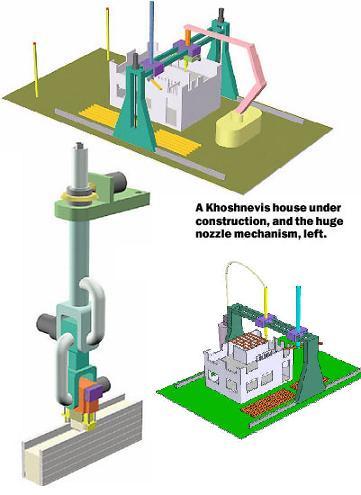An engineer from California is developing an automatic facility for constructing buildings, which will receive its precise construction instructions from the architect's computerized drawings without the need for human intervention
Yoram Ored, Galileo

Direct link to this page: https://www.hayadan.org.il/Khoshnevis.html
The process of building a building from the moment the architect's design is finished to the actual completion of the construction is long, tedious and complex. The engineer Behroch Khoshnevis (Khoshnevis) from the University of Southern California is developing an automatic facility for the construction of buildings that will receive its precise construction instructions from the architect's computerized drawings and will build the building to be erected based on them, directly from these drawings and without the need for human intervention.
ad
Like printing ink on paper
The key to this technology is a robot suspended from the head of a kind of moving scaffolding, similar to the cranes used to unload goods from cargo ships. The robot, using its computerized instructions, pours, back and forth, layers of thick cement and, as it moves, creates hollow walls that form the outline of the building, in a way reminiscent of printing ink on paper. Each time another layer of cement is applied, on top of which another layer is applied and so on.
Everywhere, the thick cement, spread on the ground like toothpaste, is enough to dry until the next application, which adds another layer to it. In this way the building goes and rises. The robot uses two sided spoons to shape the newly created layer. This process takes place continuously until the entire building route is complete. So, the robot returns to its journey along the building again, this time to fill the hollow walls.
Day long construction
Hoshenbis' goal is to build, using the robot, an entire one-story house of approximately one hundred and seventy square meters in just one day and without the use of manual labor. According to his plan, the first house with this technology will be built during the year 2005. As mentioned, the prototype of the robot that Hoshennavis is developing was suspended from the head of a moving, crane-like scaffold. Hoshenavis claims that it is possible to develop a robot that does not hang but moves on the ground along rails and while it is moving, build not one building but several buildings at the same time.
The material that Hoshenavis is currently using is cement, but Hoshenavis believes that a material that is a mixture of mud and straw might be more suitable because it dries quickly when exposed to the sun. Degussa A.G. From Dusseldorf, Germany, the world's largest manufacturer and supplier in the field of construction materials, cooperates with Hoschenbis with the aim of helping him find the best material for construction using the robot.
Illustration: A future without IP workers
The end of the era of workers?
This robotic construction technology, reminiscent of printing ink on the surface of paper, has enormous advantages. Construction with it will be possible twenty-four hours a day without interruption. According to Greg Lynn (Lynn), one of the leading architects, it will also allow the construction of buildings that have not been seen so far aesthetically. And an equally important thing - there will be no need for practitioners. Does this robot herald the end of manual labor in construction?
https://www.hayadan.org.il/BuildaGate4/general2/data_card.php?Cat=~~~960319271~~~65&SiteName=hayadan
